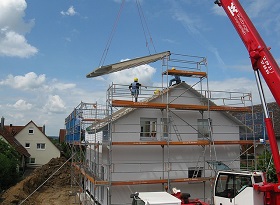Domestic building
The term 'domestic building' refers to a dwelling that has no more than one family unit resident in it, and which is used as a place of permanent or semi-permanent habitation.The most common example of a domestic building is a house.
The term ‘non-domestic building’ refers to any building that is not a domestic building.
A domestic building tends to be home to a ‘household’, which was defined in the 2011 Census as being: ‘one person living alone; or a group of people (not necessarily related) living at the same address who share cooking facilities and share a living room or sitting room or dining area’.
By contrast, the term ‘residential building’ has a wider application and can be used to refer to blocks of flats, homes of multiple occupancy (HMOs), institutions (e.g. hospitals, care homes, prisons), hotels, hostels, student halls of residence, and so on.
[edit] Related articles on Designing Buildings
- Agraharam.
- Apartment.
- Building performance evaluation in domestic buildings.
- Dwellinghouse.
- English Housing Survey 2018-19 reports released.
- Flat definition.
- House.
- Household.
- How much does it cost to sell my home.
- Living room.
- Manual to the Building Regulations.
- Mud room.
- Pantry, buttery, larder and scullery
- Proposed changes: MHCLG consultation on house building statistics.
- Residential definition.
- RIBA domestic building contract.
- Sheltered housing definition.
- Terraced house.
- Types of building.
- Types of dwelling.
- Use class.
Featured articles and news
Homes England creates largest housing-led site in the North
Successful, 34 hectare land acquisition with the residential allocation now completed.
Scottish apprenticeship training proposals
General support although better accountability and transparency is sought.
The history of building regulations
A story of belated action in response to crisis.
Moisture, fire safety and emerging trends in living walls
How wet is your wall?
Current policy explained and newly published consultation by the UK and Welsh Governments.
British architecture 1919–39. Book review.
Conservation of listed prefabs in Moseley.
Energy industry calls for urgent reform.
Heritage staff wellbeing at work survey.
A five minute introduction.
50th Golden anniversary ECA Edmundson apprentice award
Showcasing the very best electrotechnical and engineering services for half a century.
Welsh government consults on HRBs and reg changes
Seeking feedback on a new regulatory regime and a broad range of issues.
CIOB Client Guide (2nd edition) March 2025
Free download covering statutory dutyholder roles under the Building Safety Act and much more.
Minister quizzed, as responsibility transfers to MHCLG and BSR publishes new building control guidance.
UK environmental regulations reform 2025
Amid wider new approaches to ensure regulators and regulation support growth.
BSRIA Statutory Compliance Inspection Checklist
BG80/2025 now significantly updated to include requirements related to important changes in legislation.























